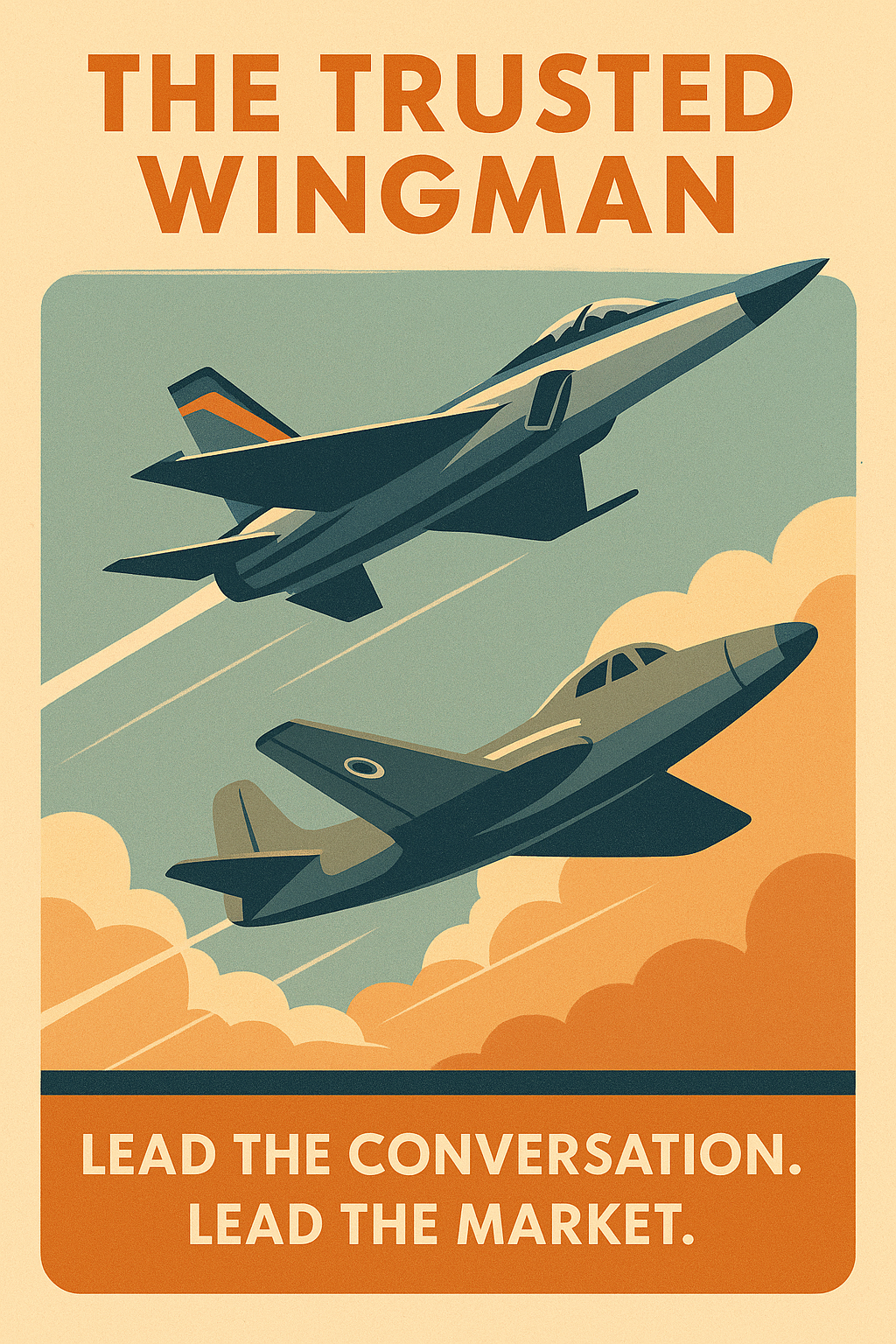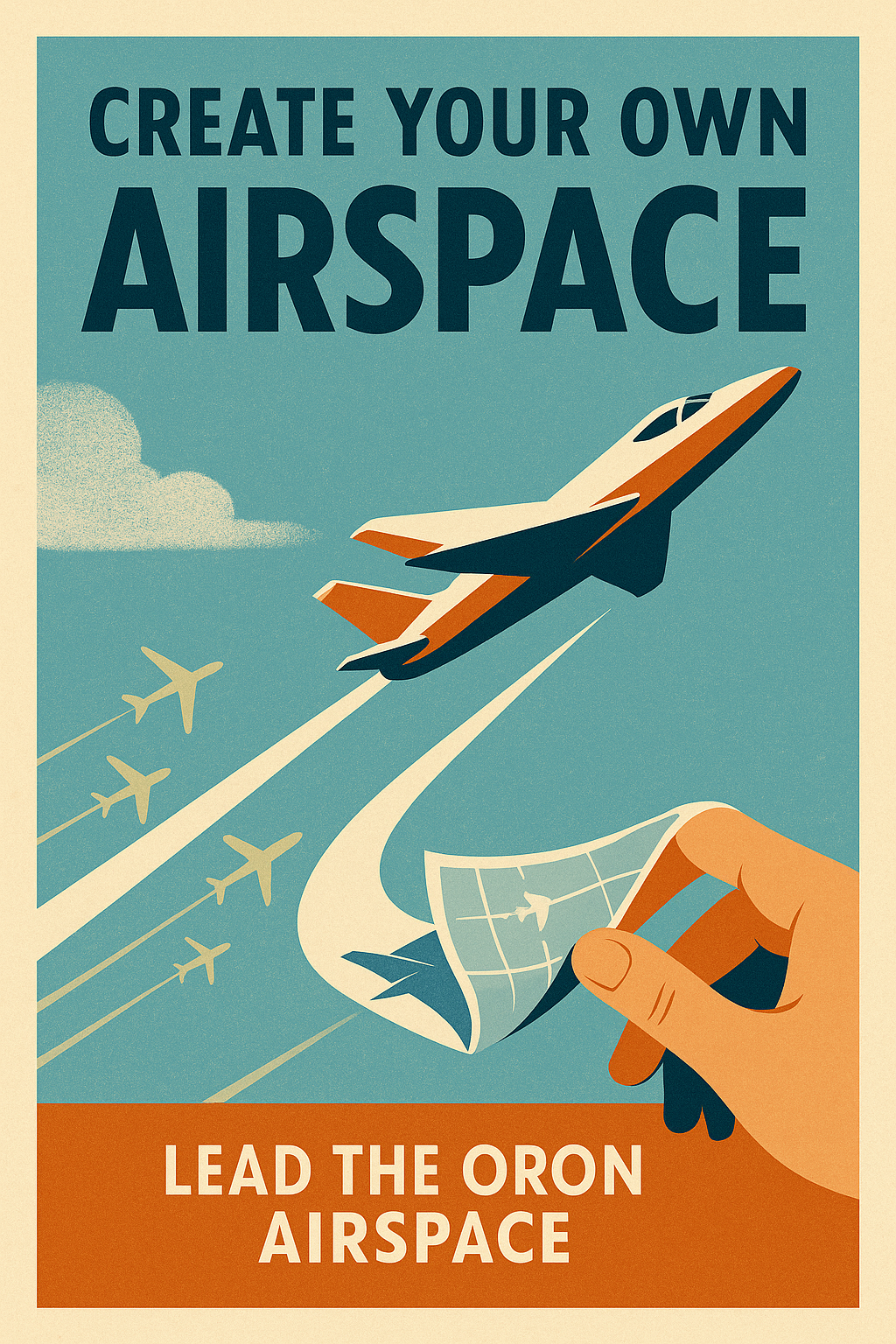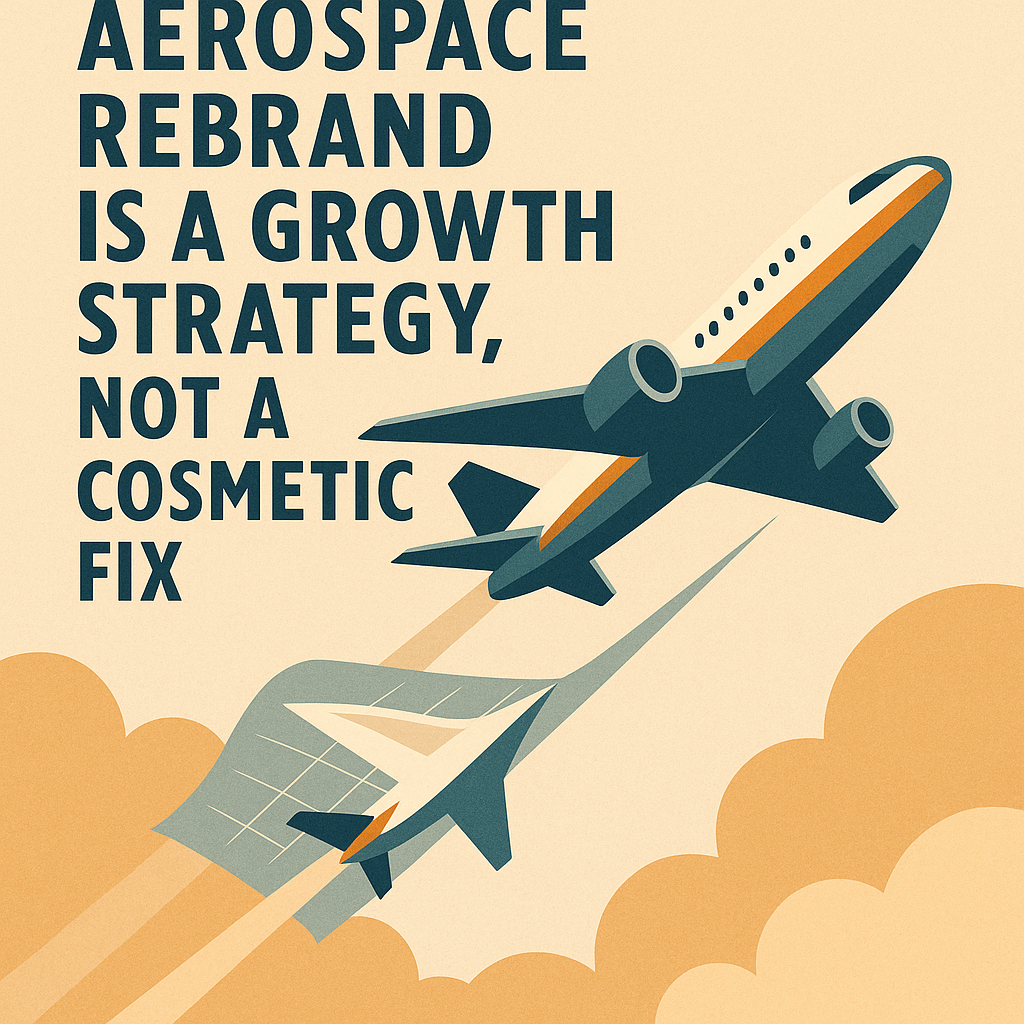You’ve got an aerospace or defense company with world-class engineering, but here’s the hard truth: no one’s paying attention—not because your tech isn’t groundbreaking, but because your brand isn’t pulling its weight.
In aerospace, even the most innovative products get sidelined if the market doesn’t understand why they matter right now.
The solution?
A strategic rebrand that goes far beyond new colors and logos.
Done right, it positions you as a leader in the global aerospace market, builds trust with key stakeholders, and drives real business growth.
I’m Viktor, a strategist who’s spent over a decade working with aerospace and defense brands, helping them build winning brands. This isn’t about “making things look nice”—it’s about rethinking how your brand communicates value, authority, and leadership in one of the most competitive industries on the planet.
This guide will show you why rebranding in aerospace is a growth strategy, not a cosmetic fix—and how the right brand strategy can put you ahead of competitors who are still stuck talking only about tech specs.
Ready to rethink your brand and claim your space in the future of aerospace? Let’s dive in.
Aerospace and Brand Strategy—The Business Case
Why Aerospace Brands Struggle with Outdated Perceptions
The aerospace and defense sector is built on engineering excellence, but when it comes to branding, many aerospace companies are still stuck in the past.
Unlike consumer-facing industries where brand identity evolves rapidly, industries like aerospace often rely on legacy reputations, technical brochures, and trade show presence as their primary form of communication.
This creates a disconnect: stakeholders see cutting-edge product and service innovation, but the brand feels rigid, overly corporate, and at times irrelevant to today’s global market.
One of the biggest challenges in aerospace and defense branding is the complexity of its stakeholder network.
You’re not just selling to a single customer; you’re building trust with B2B aerospace buyers, defense agencies, government regulators, prime contractors, and OEM partners.
Each of these audiences values something different—cost efficiency, mission readiness, sustainability, or innovation—and if your brand message isn’t tailored, you risk getting lost in procurement bureaucracy.
Another critical pitfall?
Overemphasizing technical specs while neglecting brand storytelling.
Too many defense companies focus exclusively on data sheets, certifications, and marketing materials that read like engineering manuals.
But in a globalized aerospace market, brand experience and brand visibility are as important as technical performance.
A strong brand doesn’t just communicate what you build—it conveys why it matters, how it supports environmental impact of aerospace operations, and why you’re the aerospace leader to trust for the future.
In short, aerospace marketing isn’t just about being right—it’s about being remembered.
Without a clear brand identity, even the most innovative aviation and aerospace industry solutions risk being seen as just another vendor.
Brand Strategy as a Growth Engine in Aerospace Markets
The global aerospace market is expanding, fueled by commercial aviation recovery, space exploration, and next-generation defense technology.
According to industry projections, the aerospace sector is set to grow steadily over the next decade, with major investments flowing into autonomous systems, sustainable aviation, and advanced defense technology.
But here’s the catch: as competition intensifies, price and specs alone won’t secure contracts—brand as a leader will.
A well-defined brand strategy is no longer a “nice-to-have” for successful aerospace companies; it’s a growth engine.
Differentiation is key in a market where every OEM claims “innovation.” A winning brand uses content strategy, thought leadership, and valuable content to show not just what it builds, but what it stands for. In marketing in aerospace, this means becoming the company that stakeholders—whether defense agencies or major aerospace contractors—trust to deliver the future.
Michael Porter’s principles from Competitive Strategy offer a clear lens here: competing on cost leadership alone in such a complex aerospace environment is a race to the bottom. Instead, aerospace brands should focus on differentiation and positioning, crafting a cohesive brand that signals expertise, reliability, and a vision for the future. The best practices include:
Position your brand as a trusted advisor, not just a supplier.
Develop marketing content and case studies that highlight mission impact, not just specs.
Leverage social media engagement (LinkedIn, B2B forums) to establish thought leadership in the aerospace sector.
Maintain brand integrity by ensuring brand consistency across all marketing materials and communications.
The companies that master these marketing strategies don’t just sell planes, satellites, or defense systems—they own the narrative of what the future of aerospace marketing looks like. And in a world where contracts are increasingly influenced by perception, that narrative equals revenue.
Rebranding as a Strategic Growth Move
In the aerospace and defense sector, too many companies treat rebranding as a “paint job”—a new logo, a redesigned website, or updated marketing materials.
But in today’s global aerospace market, a rebrand done right is not cosmetic—it’s a strategic repositioning that defines whether you are perceived as a brand as a leader or just another vendor.
A successful aerospace rebrand moves beyond colors and fonts to answer critical questions: What do you stand for? Why should stakeholders—OEMs, defense agencies, and companies in the aerospace ecosystem—trust you over competitors?
This level of brand and communications strategy places you in a league with industry leaders, shaping not just how you look, but how the market values you.
The best rebrands also align with the future of aerospace trends. Stakeholders increasingly prioritize sustainability, efficiency, and innovation—whether it’s the environmental footprint of commercial aviation, advancements in defense technology, or the shift toward autonomous systems.
A brand for the future integrates these narratives, signaling that you’re not just reacting to change but driving it.
This is where Blue Ocean Strategy thinking applies perfectly. Rather than fighting for contracts in the “red ocean” of price-driven competition, a strategic rebrand helps you create an uncontested market space—positioning your aerospace brand as the authority on emerging technologies, sustainability, or mission-critical innovation.
The companies that succeed here don’t just compete on specs; they own the story of where the aerospace industries are headed.
Building Trust and Credibility Through Brand Identity
In an industry built on precision and reliability, trust is currency.
For aerospace companies, that trust starts with brand identity—a consistent, cohesive representation of who you are across every touchpoint, from defense systems and OEM partnerships to aerospace engineering collaborations.
A fragmented or outdated brand sends mixed signals, eroding credibility before the first meeting even begins.
The path to leadership in the aerospace market is through thought leadership.
This means going beyond product brochures to provide valuable content that educates and inspires stakeholders.
Effective content marketing—case studies that highlight mission impact, articles on the future of aerospace and defense, and expert commentary on defense technology—builds authority.
Platforms like LinkedIn and targeted trade publications are essential for positioning yourself as the go-to voice in marketing in aerospace.
Trade shows and industry events remain crucial, but they are no longer just about booths and handshakes. The most successful aerospace brands integrate real-time digital storytelling, aerospace content at scale, and post-event campaigns to convert connections into brand advocates.
Finally, defense and aerospace industries need to humanize their brands. While technical credibility is non-negotiable, stakeholders respond to stories that show impact—how your defense company protects lives, enables sustainable flight, or advances national security. Humanizing your overall brand makes it more relatable, turning trust into a growth multiplier.
When executed well, this kind of strategic rebranding transforms a company from a supplier into an industry leader with influence far beyond contracts—it makes you the key brand stakeholders turn to when they need vision, reliability, and innovation.

Brand Identity for Aerospace Leadership
In a competitive aerospace and defense market, being technically excellent isn’t enough—you need a clear brand that communicates a compelling message.
As Simon Sinek’s Start with Why teaches, people don’t buy what you do; they buy why you do it.
For aerospace companies, this principle is even more critical because stakeholders—from government procurement officers to aerospace buyers—make decisions based on trust, vision, and long-term reliability.
Defining a strong “why” means articulating your brand as a leader in the global aerospace market. Are you advancing sustainable aviation?
Pioneering autonomous defense technology? Driving down the environmental impact of aerospace operations? A compelling vision for the future of aerospace positions your company not just as a vendor but as an innovator shaping the industry’s direction.
Once your why is clear, your brand identity must deliver that message consistently. This involves weaving a cohesive narrative—one that resonates across brand elements, from your marketing materials to your executive communications.
A strong brand storytelling strategy doesn’t just highlight technical specs; it humanizes your work, making your aerospace brand more relatable to decision-makers.
By telling stories of mission success, innovation breakthroughs, or national security impact, you appeal to both logic and emotion—the combination that wins contracts in complex aerospace industries.
Content Marketing and Thought Leadership
In the digital-first era of marketing in aerospace, content marketing is the most powerful tool for building brand awareness and authority.
Valuable aerospace content—white papers, case studies, technical insights, and thought leadership articles—establishes your company as a trusted voice in aerospace and defense.
The most successful aerospace brands understand that authority is earned through education, not self-promotion.
This means sharing insights on the future of aerospace industries, publishing B2B aerospace success stories, and contributing to respected trade publications. Stakeholders are more likely to trust a defense company that consistently provides clarity on industry trends, technology shifts, and best practices.
Jonah Berger’s Contagious offers a blueprint for making aerospace ideas spread. His principles—social currency, triggers, and stories—are perfectly suited to aerospace content strategy.
A marketer in this sector should craft content that makes decision-makers look informed when they share it (social currency), ties into timely triggers (like new defense budgets or aerospace market regulations), and embeds data within compelling narratives.
To stay ahead, integrate these principles into a content at scale approach. Use LinkedIn thought leadership campaigns, publish case studies that demonstrate ROI for defense agencies, and host webinars or panels featuring leadership in the aerospace sector. Done right, this transforms your brand from a passive supplier into an active industry leader whose voice influences procurement, policy, and future collaborations.

Case Studies—Successful Aerospace Rebrands
Two of the most successful aerospace rebrands in recent years come from Lockheed Martin and Raytheon Technologies, both of which demonstrate how a strategic shift in brand identity can reposition a defense company as an innovator, not just a contractor.
Lockheed Martin moved beyond being perceived solely as a defense manufacturer by emphasizing its role in global aerospace innovation.
Its “Frontiers of Flight” campaigns and consistent aerospace content marketing highlighted its contributions to space exploration, AI-driven defense systems, and sustainability in aerospace and defense operations.
This repositioning signaled to stakeholders—including defense agencies and investors—that Lockheed is not just building equipment; it is shaping the future of security and aviation.
Similarly, Raytheon Technologies rebranded following its merger with United Technologies, creating a unified aerospace brand that focused heavily on advanced aviation and aerospace solutions.
By investing in digital storytelling, thought leadership, and clear marketing strategies targeting OEMs and government agencies, Raytheon increased brand recognition as a leader in next-generation propulsion systems and sustainable aviation tech.
The results?
Both companies reported measurable gains—improved market share growth in defense contracts, stronger investor confidence due to clear long-term positioning, and a significant uptick in talent acquisition. In competitive aerospace industries, where engineering talent is scarce, becoming a brand as a leader directly influences recruitment and retention.
Lessons from Other Industries
The aerospace and defense sector can also learn from brands outside its traditional ecosystem, especially those known for disruptive innovation.
Take Tesla, for example. While it’s not an aerospace company, its approach to brand-led market disruption offers key lessons.
Tesla didn’t just sell electric vehicles; it sold a vision—sustainability, innovation, and a future free of fossil fuels.
By consistently aligning its brand elements with this mission, Tesla turned customers into brand advocates, creating a powerful network effect that drove both consumer demand and investor excitement.
Aerospace companies can adopt similar strategies. Instead of focusing solely on product and service specifications, they should communicate bold visions—reducing the environmental impact of aerospace operations, enabling autonomous flight, or securing global defense through AI-driven systems.
This is how marketing in aerospace evolves from transactional sales to aspirational partnerships.
Other aerospace industries—like SpaceX—have already applied these principles successfully. Through engaging aerospace content and high-visibility launches streamed worldwide, SpaceX turned highly technical missions into global events, achieving massive brand recognition that even government-led space agencies envy.
The takeaway? Whether you’re a defense company or an OEM, adopting brand strategies that blend thought leadership, visionary storytelling, and consistent brand communications is essential for staying ahead in the aerospace market.

Avoiding Common Pitfalls in Aerospace Rebranding
Despite the clear business case for strategic rebranding, many aerospace and defense companies stumble in execution. The unique challenges of aerospace industries—long procurement cycles, highly technical products, and conservative B2B buyers—make rebranding complex. Yet, most failures boil down to three critical mistakes:
1. Lack of Alignment Between Engineering Culture and Brand Strategy
Many aerospace companies have a deeply ingrained engineering-first culture that prioritizes technical excellence over storytelling.
While that precision is vital for product development, it often clashes with modern brand strategies that require emotional connection and marketing in aerospace tailored for diverse stakeholders.
When leadership fails to bridge this cultural gap, brand initiatives are seen internally as “marketing fluff” rather than growth drivers.
The result?
Disconnected brand identity, inconsistent messaging, and aerospace content that doesn’t resonate with decision-makers in the global aerospace market.
The most successful aerospace brands integrate engineering expertise into the branding process—turning technical teams into advocates and leveraging their knowledge to create innovative aerospace storytelling that builds credibility.
2. Ignoring Environmental Impact Storytelling and Future-of-Aerospace Narratives
In today’s aerospace and aviation market, staying silent on sustainability and future innovation is no longer an option.
Government regulators, defense company partners, and OEMs increasingly evaluate aerospace brands based on their role in reducing emissions, improving fuel efficiency, and advancing next-generation technologies.
Companies that ignore these narratives appear outdated, even if their technology is cutting-edge.
A strong brand identity must position you as a leader in the aerospace sector shaping the future—through aerospace content that highlights sustainability initiatives, investment in autonomous systems, or breakthroughs in innovative aerospace engineering.
3. Failure to Engage Stakeholders Early in the Rebranding Process
A common mistake in aerospace rebranding is treating it as a top-down exercise driven solely by marketing teams.
In reality, success depends on early engagement with stakeholders—from engineers and procurement teams to government partners and OEM collaborators.
Ignoring their input risks creating a brand identity that feels disconnected from operational realities, weakening trust.
The most effective marketing strategies in the aerospace market involve co-creating messaging with these key groups, ensuring that every brand element reflects technical credibility while staying relatable to buyers.

The Future of Aerospace Branding
If there’s one takeaway, it’s this: staying ahead in the aerospace market isn’t about who has the most advanced product—it’s about who owns the conversation.









